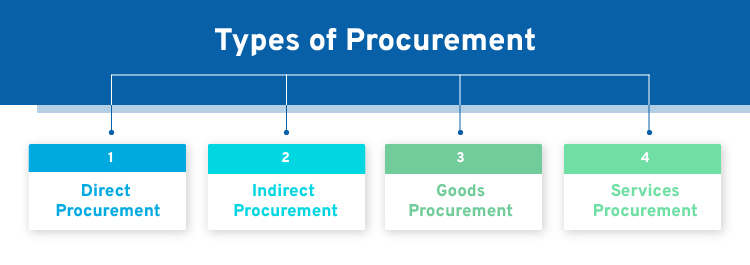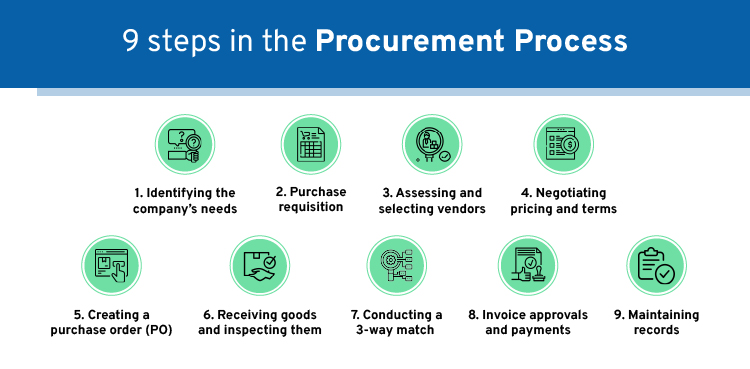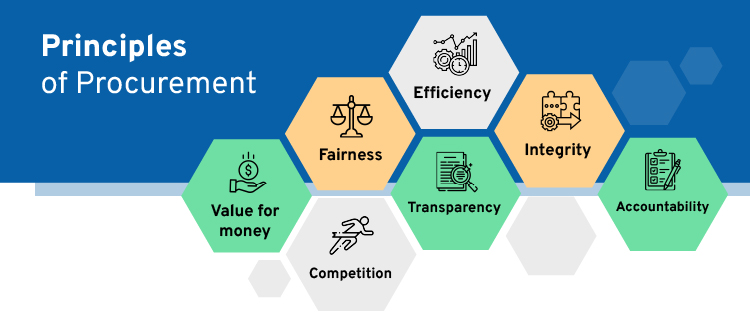Procurement that involves manual processes and is paper-driven has a cascading effect on an organization’s bottom line. These inefficiencies can be harmful to any organization and can cost the company a large chunk of cash in the form of delayed purchasing, transaction disputes, and missed opportunities on discounts.
Speeding up procurement processes with the help of spreadsheets and emails is definitely not the right way. Automating your purchasing cycle will go a long distance and effectively save costs and increase efficiencies.
Procurement includes activities that are performed to obtain certain goods or services for your organization. Procurement essentially refers to structured methods and techniques to streamline a company’s procurement process to achieve the desired results.
Procurement involves activities required to support an organization’s daily operations which include sourcing, negotiating terms and conditions, purchasing items, receiving and running checks on goods if necessary, and most importantly, keeping records of all the steps in the process.
Procurement is truly successful when the desired results are achieved while saving costs, reducing time, and building stronger and longer-lasting supplier relationships. In simple terms, the purpose of procurement is for purchasing teams to work together to obtain supplies at a competitive rate while delivering the most value.
One of the most important aspects of improving your procurement processes is minimizing costs. Cost savings happen when your organization has identified good quality suppliers. These suppliers provide the best quality of goods and services that the company needs and have the capacity to consistently deliver with trust.
Here is why procurement is important in business.
Improved bottom line profits
Often, procurement activities take up a huge chunk of a company’s annual budget. The profit margin and the bottom line of a company are directly affected by the cost of goods and services bought. Because these costs are unavoidable, it is crucial that an organization has a procurement strategy in place.
When that is the case, implementation of an automated procurement software can result in mammoth savings in your expenditure. Even minor savings can have a huge impact on the company’s finances, which means your profit margins increase as well.
Risk management in supply chains
The recent global crisis was a lesson in how risk management in supply chains was crucial for survival. A smooth and consistent flow of goods is the hallmark of a healthy supply chain. One of the cornerstones of effective and efficient procurement is supplier management.
This involves identifying your most reliable and credible suppliers and nurturing long-term relationships with them. The benefits that come with this involve cost reductions, and improved communications, resulting in a low chance of disruption, hence managing the risks in the supply chain.
Drives the long-term strategy of your business
Businesses are always seeking growth with the help of technology. This enables the fast-paced expansion of the company. However, supply chains cannot always catch up with this pace. Many suppliers face a shortage of materials because they have not updated themselves and you can’t always afford it.
Inputs from the procurement team are vital as they can help your business avoid problems related to scaling. With the help of a procurement team, your company can drive a successful growth strategy by identifying new suppliers and educating the old ones by maintaining good relations with them. This will ensure constant access to essential goods in the future.
Improved sustainability
The more globalized the supply chains become, the more complex they are to maintain. Technological advancements in the supply chain have opened doors to international suppliers and markets. Hence, enforcing and maintaining quality standards is tough but it is essential. Especially when the source of your goods is located thousands of miles away.
The younger generation of consumers is often concerned about issues such as sustainable pricing, ecological conservation, and labor standards. All of these factors can affect procurement. It is essential that your organization considers how procurement affects your corporate social responsibility (CSR) and brand image.
While procurement can be categorized in several ways, there are 4 main types in which they can be categorized. Let’s look at them.
Direct procurement
Just like the name suggests, direct procurement is the purchase of raw materials which are required to produce an end-product i.e. direct purchase of raw goods, machinery, etc. that directly contribute to the company’s end product. Procurement officers and contracted suppliers are the key stakeholders in direct procurement processes.
Indirect procurement
This type of procurement involves purchasing something like office supplies. This means that indirect procurement does not involve goods that don’t directly affect the company’s bottom line or end product. These goods usually support the day-to-day management of the business. Office managers in a small company are tasked with indirect procurement processes.

Goods procurement
Goods procurement refers to the procurement of physical items. It can also include the purchase of items like software subscriptions. If a company practices good supply chain management practices, goods procurement is usually smooth and hassle-free. It can include both direct and indirect procurement.
Services procurement
This type of procurement focuses on procuring people-based services. It can involve the hiring of temporary staffers, leasing software, procuring short-term vendors to work at an upcoming seminar, etc.
An example of economies of scale is when you buy an item in bulk because buying more ultimately means that you’re getting each unit at a lower price. For businesses, cost savings occur as a result of making more products. What this means for companies is that a business can increase its profits by making their production processes more efficient, rather than increasing the price of a product.
Economies of scale can be achieved in various parts of the business:
An efficient procurement process is just one way in which businesses can achieve economies of scale. An efficient procurement function can provide many financial benefits to an organization, helping them further achieve economies of scale.
Shared Business Functions: A purchasing system can help businesses share information and duties across all departments. If a business has an accounting department in another location, they can easily collaborate with other departments using one platform.
Staff Efficiencies: The automation that can be achieved with a procurement process will require fewer employees and can make employees’ tasks simpler so that they can get more done.
Purchasing: When it comes to purchasing, buying in bulk can cut costs. Larger spend and greater purchasing leverage can result in reduced prices and costs.
Data: Procurement software offers greater and more efficient data for financial and inventory records, making it easier for business owners to make decisions and save on costs.
Further Cost Savings: With lower supply and service costs, there is potential for higher bottom-line profitability. Cost reductions can be quantified, projected, reported, and audited.
The procurement process varies for every organization based on the company’s structure and the nature of the business. Generally, the following steps are considered the main steps in a procurement process.
Identifying the company’s needs
Firstly, a business first has to recognize its needs and sketch out a plan accordingly. This helps in the seamless procurement of goods and services in a timely manner at a reasonable cost.
Purchase requisition
When an employee or the procurement team needs to procure a number of goods or services, they make a formal purchase request i.e. a purchase requisition. A requisition notifies the company that a need exists. The requisition consists of details like price, time frame, quantity, etc. The request is then submitted for approval and is either accepted or rejected based on the details given in the request. Once approved, the procurement team can select a vendor and make the purchase.
Assessing and selecting vendors
Once the purchase request is approved, the next step is finding and selecting the best vendor and submitting a request for a quote (RFQ). RFQ is what the purchasing team sends to the potential suppliers to receive the best quote. The selection of vendors should not just depend on the best price offered but also on reputation, reliability, lead times, quality, etc.
Negotiating pricing and terms
Most companies get at least three quotes from suppliers before coming to a decision. Examining each quote thoroughly is crucial as a negotiation can happen only when you have studied the quotes well. Once your company has selected a quote, make sure you get the terms in writing.
Creating a purchase order (PO)
Now that the supplier has been selected, you will now have to create a purchase order and send it to the supplier. The PO should contain all the necessary details to identify the exact goods or services needed and to send the correct order on time.

Receiving goods and inspecting them
Once the supplier sends the order out and your organization receives it, it is essential that you check for any errors or damages while receiving the order itself. Check if what you received is exactly as mentioned in the PO and that the quality meets the expectations.
Conducting a 3-way match
A 3-way match is done by the accounting team. The accounts payable should conduct a 3-way match by comparing the purchase order, order receipt, or packing list/invoice. This is done so that there are no discrepancies in the goods or services received and they match the PO. This prevents payment for unauthorized or inaccurate invoices.
Invoice approvals and payments
Once the 3-way match is accurate, approve and pay the invoice. Having a consistent invoice payment process through accounts payable can set your company up for success as there is very less room for error. A standardized process means that invoices are always paid on time and you can have strong, long-lasting relationships with your suppliers.
Maintaining records
It is extremely crucial that your organization maintains a record of the entire procurement process i.e. from creating a request to negotiating on price, invoices, receipts, and everything in between. Having a record helps the company to reorder the goods at the right time and compare the prices of past purchases as well.
The entire procurement as discussed above can also be thought of in 3 distinct stages. Let’s have a look.
Sourcing stage
The sourcing stage has all the initial steps of a procurement process. This is where a business identifies the needs, creates a requisition, and assesses and selects vendors. Once these steps are complete, many organizations consider it a good practice to establish a strong and long-lasting relationship with suppliers. This will help a company to develop trust among the suppliers.
Purchasing stage
The purchasing stage involves the negotiating aspect of the procurement process. Not just that, it also involves creating orders, receiving, and inspecting goods and services.
Payment stage
This stage is where the accounts payable conducts a 3-way match to ensure the accuracy of the order and invoice. After this, the invoice can be approved and payment can be made. Records of all invoices, orders, and payments should be maintained for further reordering and comparison of prices.
Every procurement management process consists of three components. These three components work together to make the procurement process happen. Let’s have a look at them.
People
The people in the procurement process are the ones who are responsible for starting or authorizing every step in the process. Other than the usual purchasing specialists, the people also include other stakeholders like accounts payable and the business groups that request the goods and services. More number of stakeholders are involved if the value of the goods or services is high as the approval will happen on multiple levels.
Process
An efficient procurement process can improve a company’s bottom line by keeping the costs down and ensuring supplies arrive when needed. A seamless and methodical process promotes accuracy and ensures things happen on time. When every person involved in the process knows exactly what they need to accomplish and when the tasks need to be completed, it is a sign of an efficient procurement process.
A disorganized procurement process will result in inefficiencies and negatively impact the bottom line while spoiling relationships with suppliers.
Paperwork
Maintaining records for every stage of the procurement process act as a plethora of organizational knowledge. These records contain important information about payment terms and supplier performance which help the business maintain an efficient procurement process. The records can be maintained digitally or electronically to ensure efficiency.
Even if there is a staff change in the organization, these records help the new staff to catch up with past records and how the procurement process functions. These records are crucial when there is an audit or a dispute as it helps to establish a trail and trace back to where it all started.
Economies of scale are all about the cost-savings that allow businesses to make more of a product for less. Centralization of the purchasing process can offer real-time analytics about the financial benefits that come from this type of scale and growth. An effective procurement function allows for:
Organized Planning: With an effective procurement process, your department will be able to develop a plan to address expense categories over a certain period of time.
Specialization: Your purchase department will be able to organize staff around products, supplies, and services to improve results and boost sales.
Supplier Relationships: Purchasing teams will be able to more easily determine the interest, capabilities, competitiveness, and financial strength of suppliers. This process will eliminate suppliers that may not be ideal to work with.
By vetting suppliers, you will have a list of fewer supplies which helps keep costs to a minimum as only this small amount of “verified” suppliers is paid regularly.
Profitability and Growth: Cost reductions from an efficient purchasing department will reduce overall costs and increase profits.
While it is largely similar, there are a few differences in procurement of public sector organizations and private sector organizations. In the public sector, it is highly possible that the people involved in the procurement process handle sensitive public funds.
Because they are public funds, there is a need for an ethical code of conduct which will hold public servants accountable for their purchases. These are called the principles of procurement. Some of these principles could be applied to the private sector as well. Let’s understand some of the most common principles of procurement.
Value for money
For any organization, it is essential that they manage funds efficiently and economically when procuring goods and services. Risk assessments and cost-benefit analysis are a good way to determine ways to save costs. Low costs accompanied with good quality and durability is equally important.
Fairness
While dealing with suppliers or individuals, procurement should be done in all fairness without showing bias towards any supplier or individual. All bids need to be looked at and considered objectively, based on how well they meet your company’s needs.
Competition
Unless there are terms about only sourcing from a sole-source provider, organizations should seek multiple competitive bids from multiple suppliers. This promotes a healthy relationship between the company and suppliers and you can have multiple suppliers for future orders who are good quality.
Efficiency
Efficiency in procurement processes can be achieved by avoiding delays, maximizing value and automating the entire purchasing cycle. This ensures cost savings and a visible improvement in the bottom line profits.

Transparency
Unless there are legal reasons or some other reasons to keep procurement information confidential, organizations should be open to transparency. The public and the suppliers can know the relevant procurement information and that way, there will be less speculation towards an organization hiding information about their processes.
Integrity
When it comes to a public organization, the funds must be used for the intended purpose only and in public interest. The procurement teams of a public organization must always strive to be honest, reliable, and trustworthy while being responsible.
Accountability
It is common knowledge that the procurement team involved in the procurement process are accountable for their actions and decisions. The procurement activities need to be reported accurately, including any errors.
Procurement key performance indicators or KPIs, are essentially a type of procurement measurement tool that are used to evaluate and monitor the efficiency of an organization’s procurement management. These can help your company to optimize and monitor spending, quality, time, and cost.
The following are the KPIs that every organization should keep a track of.
Checkout the details of all procurement KPIs and how to measure them accurately to ensure you always have the right data in right context.
Copyright 2024 @ Bellwether Software. All rights reserved.
201 E. Kennedy Blvd., Suite 1950, Tampa, FL 33602, United States
